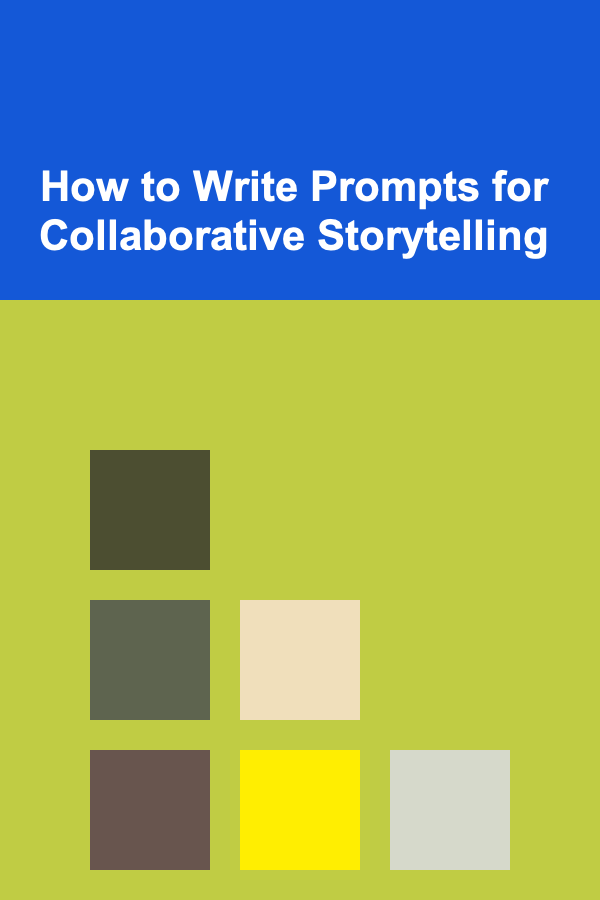
How to Write Prompts for Collaborative Storytelling
ebook include PDF & Audio bundle (Micro Guide)
$12.99$7.99
Limited Time Offer! Order within the next:

Collaborative storytelling has emerged as one of the most engaging and rewarding forms of creative writing. It brings together diverse voices, allowing for an intricate blend of ideas, characters, and plots that might not be achievable in solitary writing. One key aspect of collaborative storytelling is the creation of prompts that serve as starting points, guiding participants through the narrative journey. A well-crafted prompt can ignite creativity, spark intriguing character development, and set the stage for a rich and dynamic story.
In this guide, we will delve into the nuances of writing prompts for collaborative storytelling, exploring how to craft prompts that foster collaboration, encourage creativity, and enhance the overall storytelling experience.
Understanding Collaborative Storytelling
Before we dive into the mechanics of writing effective prompts, it's crucial to understand the nature of collaborative storytelling. At its core, collaborative storytelling is a collective endeavor in which multiple writers contribute to a shared narrative. This could be through written exchanges, online role-playing games (RPGs), writing groups, or other mediums where a group of people collaboratively builds a story.
Collaboration can take many forms:
- Shared Control of the Plot: Different writers might control different characters or elements of the story world.
- Group Brainstorming: Participants may contribute ideas that others then develop further.
- Threaded or Episodic Storytelling: Writers may take turns to write sections or episodes of a larger story.
The role of a prompt in this context is to provide direction without restricting the freedom of the participants. It should serve as both a launchpad and a guide, leaving enough room for creative freedom while ensuring a shared narrative vision.
The Power of a Good Prompt
A good prompt serves as the cornerstone of collaborative storytelling. It has the ability to:
- Inspire Creativity: A well-designed prompt can spark fresh ideas and encourage writers to explore uncharted territories.
- Set Boundaries: A prompt can also provide boundaries or rules that help keep the narrative focused and cohesive.
- Encourage Collaboration: Prompts should invite multiple interpretations, giving each collaborator a unique opportunity to influence the direction of the story.
- Create Shared Worldbuilding: Prompts can suggest elements of the world, including setting, characters, and themes, that can be expanded upon by multiple storytellers.
The goal of a prompt is not to dictate the entire direction of the story but to provide a foundation that writers can build upon.
Types of Prompts for Collaborative Storytelling
There are various kinds of prompts, each suited to different aspects of collaborative storytelling. The choice of prompt type will depend on the kind of story you wish to tell, the number of participants, and the desired outcome of the collaborative effort. Here are several types of prompts you can use to kickstart your collaborative story.
3.1. Scenario-Based Prompts
These prompts provide a specific scenario or situation that participants can work from. Scenario-based prompts can set the stage for the story, allowing writers to explore characters' responses, emotions, and decisions in a particular context.
Example:
- "A massive storm has trapped a group of strangers in a remote cabin in the mountains. The power goes out, and they realize that someone is missing. As tensions rise, the group must figure out how to survive the storm and find the missing person. What happens next?"
Why it works: This type of prompt provides a high-stakes situation that encourages participants to explore tension, conflict, and character dynamics. It invites multiple possible outcomes and ensures that each contributor has a role in advancing the plot.
3.2. Character-Centric Prompts
Character-driven prompts focus on introducing a character and setting up a challenge, situation, or goal for them. Writers can then build on that character's development, relationships, and arc throughout the collaborative story.
Example:
- "Evelyn is a skilled thief who is hired to steal a rare artifact from a high-security museum. However, she has a secret: the artifact belongs to her estranged father, who disappeared years ago. How does Evelyn grapple with her conscience as she prepares for the heist?"
Why it works: Character-centric prompts give participants the opportunity to explore deep character motivations, conflicts, and growth. They allow for a broad range of contributions, as each writer may interpret the character's actions differently and push the plot forward.
3.3. Worldbuilding Prompts
Worldbuilding prompts help establish the setting or environment for the story, offering participants the chance to explore and expand on the world in which the narrative takes place. These prompts can range from highly detailed to more abstract, depending on the level of collaboration desired.
Example:
- "In a world where everyone is born with a unique magical power, a young girl named Lyra discovers that her power is to control time itself. But the time in her world is constantly shifting, making it difficult to control. What kind of world is this, and how does Lyra's ability impact it?"
Why it works: Worldbuilding prompts give participants a solid foundation for their stories. They set the tone, style, and structure of the narrative world, giving writers the flexibility to create intricate plots and explore various societal, political, and environmental factors.
3.4. Dialogue-Driven Prompts
These prompts provide a snippet of dialogue between two or more characters. The dialogue can serve as a point of conflict, humor, or revelation, and it encourages writers to explore the relationships between characters and advance the plot through conversation.
Example:
- "'You don't know what you're dealing with,' Sarah said, her voice trembling. 'If you don't stop now, we're all going to die.' 'I'll take my chances,' replied Jake, his tone unwavering. 'We don't have time for this.'"
Why it works: Dialogue-driven prompts allow for rich, dynamic character interaction. They also encourage writers to take the conversation in unexpected directions, creating tension and drama that propels the story forward.
3. Object or Artifact Prompts
These prompts introduce an object or artifact that holds significance in the story. The object can be mysterious, powerful, or central to the plot, prompting characters to react to it in different ways.
Example:
- "An ancient book with an untranslatable language appears on the doorstep of a small, isolated town. No one knows who left it there, but the townspeople begin experiencing strange, unexplainable events after it arrives."
Why it works: Object-based prompts provide tangible elements around which the story can revolve. The mystery of the object or artifact invites exploration, and it offers multiple directions for collaboration, as each writer can introduce new clues or consequences tied to it.
Crafting Effective Prompts
To create a compelling and effective prompt, there are several factors to consider. A good prompt will not only inspire creativity but will also encourage collaboration. Below are some key elements that should be considered when crafting a prompt for collaborative storytelling.
4.1. Provide Enough Flexibility
A prompt should offer enough detail to set the stage but also leave room for interpretation. Writers should have the freedom to explore and build upon the initial idea, rather than feeling constrained by too rigid a structure.
- Example of Too Restrictive: "The character must make this exact decision, and the plot must go in this direction."
- Better Approach: "The character faces a difficult decision, and the consequences could go in several directions."
4.2. Encourage Conflict
Conflict is essential to driving a story forward. A good prompt should introduce a problem, challenge, or conflict that participants can explore through their characters' decisions and interactions. Whether it's internal conflict, external obstacles, or interpersonal tensions, conflict is a key ingredient for compelling storytelling.
4.3. Leave Room for Character Development
Prompts should give participants the opportunity to dive into character motivations, desires, and arcs. A well-crafted prompt will not only spark immediate action but will also set up possibilities for ongoing character development.
4.4. Establish a Clear Focus or Theme
A successful prompt should have a clear focus or central theme, whether it's survival, love, mystery, or something else. However, it should also allow for creative divergence, so that writers can bring their own perspectives and ideas into the collaborative effort.
Conclusion
Writing prompts for collaborative storytelling is an art form in itself. By creating prompts that are engaging, flexible, and open-ended, you can foster a collaborative environment where creativity thrives. Whether you're focusing on characters, worlds, or conflict, the key is to provide a spark that invites multiple contributors to build upon, interpret, and evolve. With the right prompts, the possibilities for collaborative storytelling are endless, offering a rich and dynamic experience for all participants involved.
Reading More From Our Other Websites
- [Home Space Saving 101] How to Keep Your Kids' Toys Organized with Toy Storage Solutions
- [Horseback Riding Tip 101] Stay Balanced: Core Strength Hacks Every Horseback Rider Should Know
- [Organization Tip 101] How to Use Checklists to Keep Your Workspace Decluttered
- [Organization Tip 101] How to Choose the Right Furniture for Small Spaces
- [Survival Kit 101] The Ultimate Tech‑Enhanced Survival Kit: Solar Chargers & Satellite Messengers
- [Organization Tip 101] How to Organize a Collaborative Hobby Space with Friends
- [Sewing Tip 101] Step-by-Step Guide to Sewing Your First Zero-Waste Wardrobe Essentials
- [Home Soundproofing 101] How to Soundproof Your Home Office for Maximum Focus
- [Home Pet Care 101] How to Deal with Pet Separation Anxiety in Your Home
- [Toy Making Tip 101] DIY Family Fun: Crafting Hand‑Made Toys Together

How to Budget for Major Home Renovations
Read More
How to Sell Digital Products Successfully for Alternative Health Practitioners
Read More
How to Use Job Alerts Effectively: Set It and Forget It
Read More
How to Understand Climate Justice and Equity
Read More
Exploring Nanotechnology in Everyday Life: A Deep Dive
Read More
Exploring Mitochondrial DNA and Ancestry: A Comprehensive Guide
Read MoreOther Products

How to Budget for Major Home Renovations
Read More
How to Sell Digital Products Successfully for Alternative Health Practitioners
Read More
How to Use Job Alerts Effectively: Set It and Forget It
Read More
How to Understand Climate Justice and Equity
Read More
Exploring Nanotechnology in Everyday Life: A Deep Dive
Read More